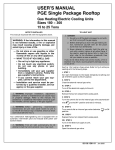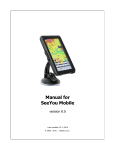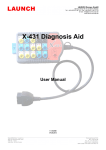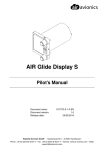Download EQP-112 Off-Car Ignition Coil Tester
Transcript
Off-Car Ignition Coil Tester Instruction Manual TEST REPAIR EQP-112 Off-Car Ignition Coil Tester REPLACE 2 The EQP-112 Ignition Tester is a portable tool for testing a variety of ignition coils off the vehicle to determine if the output spark is acceptable. Function Descriptions: Can output two sets of drive signals at the same time; Has anti-interference ability, good stability, high load capacity; Small, easy to use; Output signal divided into “direct signal” and “within module” signal allows ignition coil with integrated module and without module to be tested; Discharging electrode spark gaps are easily adjustable. Ignition Coil Tester Control Panel Discharging Electrode Location. Metal Case. Direct Output Signal (to test ignition coils without modules). Integrated Module Output Signal (to test ignition coils with module). Packing list of included components: Ignition Coil Tester. High‑Voltage Leads (Red x 1, Black x 1). Discharge Electrodes (Metal x 1, Plastic x 1). 2-Wire Cable for testing ignition coils WITHOUT module. 3-Wire Cable for testing ignition coils WITH module. Start / Stop Button for starting and ending test. Power Light. Power Switch. Power Fuse. TEST REPAIR Assembly and Test Procedure: A. Place the discharge electrodes in the holes provided at the top of the tester case as shown. B. Adjust the electrode gap to approximately 1cm. REPLACE 3 Example : VW Ignition Coil For example, to test this VW ignition coil and module assembly (032905106B) which has two sets of high‑voltage outputs, one primary input connector and an ignition module. The 3‑Wire harness cable should be used to test this type of assembly. Left high‑voltage output. Ignition module. Right high‑voltage output. C. Select the cable required according to ignition coil type (with or without module). D. Connect 3‑Wire harness cable to the combined module & ignition coil. NOTE: Primary Connector Terminals Ignition coil pin configurations vary on different coils. Please CHECK for correct pin configuration on ignition coil to be tested before connecting the harness. 4. “G” terminal. 3. Left high- voltage connect IB signal terminal. 4. Black 3. Yellow Wire. This typical waste spark ignition coil pack requires two outputs (one ignition coil) to be tested at a time. The other two outputs must be tested separately. Wire for left side. 2. “+” terminal. 1. Right highvoltage connect IB signal. 2. Red Wire – 1. To test the right power supply. side, move the Yellow wire to this pin. Test Cable – 3‑Wire to be used for coils with module “+” Terminal : Red “IB” Terminal : Yellow “G” Terminal : Black [continued] TEST REPAIR Assembly and Test Procedure (continued) : E. Connect high‑voltage leads. NOTE : Testing One Coil (two high‑voltage outlets as shown) REPLACE 4 H. Ensure all connections are correct and press the “Start” button. WARNING: High‑Voltage at the discharge electrodes may be harmful. Do not touch the discharge electrodes during test. I. Observe discharge electrodes. The condition of the spark generally indicates the condition of the ignition coil. i.e. : A strong blue spark is an indication of a healthy ignition coil. A weak orange spark is generally the result of a weak or faulty ignition coil. J. On completion of the spark output test press the START / STOP button to end the test. F. Connect test unit to a 12 Volt power source. K. Remove and WARNING: High‑voltage at the discharge electrodes may be harmful. Do not touch the discharge electrodes during test. reconnect the high-voltage leads to the other suitable ignition coil outlets to complete the ignition coil test. G. Switch the power switch to the “ON” position. L. The 3 pin wire harness will also need to be altered at the ignition coil to suit the other half of the coil pack (other two high-voltage outlets) to be tested. The “PWR” light should illuminate. (Check connections and power supply if light does not illuminate). M. Repeat steps from G to J to monitor the output spark to determine if the ignition coil is acceptable. [continued] TEST REPAIR REPLACE Testing a typical Coil over plug (COP) WITH integrated module: 5 Example : Toyota Coil Toyota Coil (90919-02230), this item has an ignition module. The 3‑Wire harness must be used. A. Place the discharge electrodes in the holes provided at the top of the tester case as shown. B. Adjust the electrode gap to approximately 1cm. Toyota / Lexus Battery Volts C. Select the harness cable to suit the ignition coil Feedback to ECU to be tested. For example the Toyota Coil (90919-02230) [at right] has an integrated ignition module. The 3‑Wire harness must be used. Pulsed Coil Control D. Connect the 3‑Wire harness to the “SIGNAL OUTPUT” socket on the test unit. G. Connect the other end of the high‑voltage lead to the brass connector of the plastic discharge electrode. NOTE: Only one high‑voltage lead is required for this test (one output per coil). E. Connect the 3‑Wire harness to the ignition coil to be tested. Ensure correct configuration. H. Recheck all connections. I. Connect test unit to a 12 Volt power source. F. Connect one end of the high‑voltage lead to the secondary output of the ignition coil. Ensure the high‑voltage lead contacts the spring or contact. WARNING: High‑voltage at the discharge electrodes may be harmful. Do not touch the discharge electrodes during test. [continued] [continued] TEST REPAIR Testing a typical Coil over plug (COP) WITH integrated module (continued) : REPLACE 6 Testing a typical Coil over plug (COP) WITHOUT integrated module: A. Place the discharge electrodes in the holes provided J. Switch the at the top of the tester case as shown. power switch to the “ON” position. B. Adjust the electrode gap to approximately 1cm. The “PWR” light should illuminate. (Check connections and power supply if light does not illuminate). K. Ensure all connections are correct and press the “Start” button. C. Select the harness cable to suit the ignition coil WARNING: High‑Voltage at the discharge electrodes may be harmful. Do not touch the discharge electrodes during test. to be tested. For example IGC-163 Ford Falcon ignition coil has no internal module. D. The 2‑Wire harness must be used and connected to the “MODULE OUTPUT” socket on the test unit. L. Observe discharge electrodes. The condition of the spark generally indicates the condition of the ignition coil. i.e. : A strong blue spark A weak orange spark is generally the result of a weak or faulty ignition coil. is an indication of a healthy ignition coil. E. The other end of the harness must be connected to the two terminals of the ignition coil. RED Wire to B+ Terminal M.On completion of the spark output test press the START / STOP button to end the test. [continued] TEST REPAIR Testing a typical Coil over plug (COP) WITHOUT integrated module (continued): REPLACE 7 J. Switch the power switch to the “ON” position. F. Select one end of the high‑voltage lead to the secondary The “PWR” light should illuminate. (Check connections and power supply if light does not illuminate). output of the ignition coil. Ensure the high‑voltage lead contacts the spring or internal contact. K. Ensure all connections are correct and press the “Start” button. G. Connect the other end of the high‑voltage lead to the plastic discharge electrode. NOTE: Only one high‑voltage lead is required for this test as there is only one secondary output. WARNING: High‑Voltage at the discharge electrodes may be harmful. Do not touch the discharge electrodes during test. L. Observe discharge electrodes. The condition of the spark generally indicates the condition of the ignition coil. i.e. : A strong blue spark A weak orange spark is generally the result of a weak or faulty ignition coil. H. Recheck all connections. I. Connect test unit to a 12 Volt power source. M.On completion of the spark output test press the START / STOP button to end the test. WARNING: High‑voltage at the discharge electrodes may be harmful. Do not touch the discharge electrodes during test. is an indication of a healthy ignition coil. Specialty Tools & Equipment you can count on ! REPAIR REPLACE Quality Products 12 Month Warranty Technical Support Available from leading automotive specialists and retailers. www.plusquip.com.au PLUSQUIP 8049 05/13 TEST
















